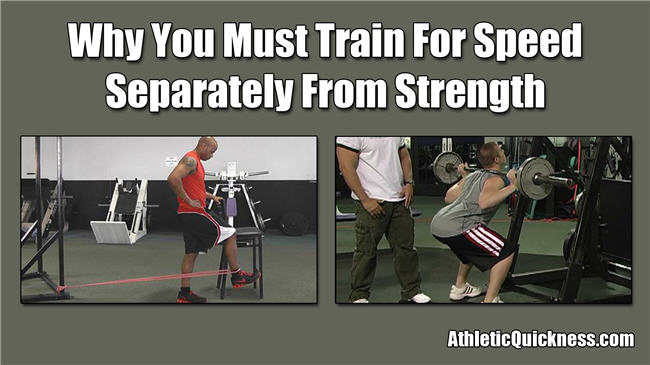You Need Both Speed and Strength
and
Why They Must Be Trained Separately
You can not train for speed the same way you train for strength, and you must understand the difference – because your muscles will know the difference …..
In other words, if you think you are training for speed, and your muscles think you are training for strength, your muscles will be right every time!
So what is the answer for getting faster muscles?
Let me clarify this a little bit more before going on. If you remember from anatomy, all skeletal muscles consist of two main fiber types:
- Slow twitch fibers, which are primarily for strength and endurance
- Fast twitch fibers, which are primarily for speed of muscular contraction.
Since your muscles have two different fiber types with two different functions, you will absolutely need at least two different methods of training your muscles to improve upon their 1) speed and 2) strength/endurance.
There isn’t any one type of athletic training exercise capable of effectively making your fast twitch fibers faster and your slow twitch fibers stronger at the same time.
You cannot separate these fibers apart and train them individually. What ends up happening is that you either train your entire muscle for better speed or you train your entire muscle for better strength, but never effectively for both at the same time.
For example, when training extensively with weights and repetitions your fast twitch muscles fibers will start behaving like slow twitch fibers. Of course, this will happen, even if you believe you are training for speed. The results will be more strength but disappointing results in speed improvement.
This is one reason why I disagree with those who say lifting heavy weights at low repetitions is for strength and lifting lighter weights at faster repetitions is for speed. How do you know (better yet, how does your body know) at what repetition speed the training switches from a slow twitch program to a fast twitch program? The answer is, it doesn’t. They’re both strength training routines.
Is Plyometric Training The Answer?
Plyometric training is supposed to be today’s answer to this dilemma. It usually involves using your own body weight in exercises such as drop-jumping from a raised platform or box to the ground, and then immediately jumping up. Bounding is where over-sized strides are used in the running action and extra time spent in the air.
Running steps is another type of bounding plyometric routine. Upper body plyometrics would include push-ups with a clap at the top of the motion and the use of the medicine ball. All of these types of exercises have value to the athlete.
These plyometric workouts are all primarily great strength training programs. All of them are fantastic at improving your muscle strength and increasing your overall muscle strength will definitely help you perform better. Added strength, for example, provides a more efficient means of moving your body.
This can and does help with your speed, but it is still never even close to the true speed potential that a particular muscle is capable of delivering.
As I said earlier, muscles have two distinct fiber types. These different fiber types cannot be separated apart from each other and trained individually. Depending on your training methods, you either end up training the entire muscle for better strength or for better speed, but never for better strength and speed at the same time.
What you end up with is a program that is really good at improving one thing but with little or no effect at improving the other. And if your training involves too much of one, as in too much speed training or too much strength training, it can have a negative effect on the other and you can actually lower your athletic performance.
This is why it really pays to understand what exactly a certain type of training is really going to accomplish – more speed or more strength. Too often athletes hit the gym to get stronger only to follow this with a heavy dose of plyometrics – primarily another strength routine.
Hitting plateaus with these types of training happens very quickly, and it can be months and more likely years before they are broken through. This can lead to frustration and all too often the experimentation with performance enhancing substances.
Is Isometrics Training the Answer?
This brings us to isometric training. The word itself carries a lot of old “baggage” for some. Many who are familiar with this term relate isometrics only to weight training and see it simply as another limited strategy – good for helping you get past a week spot in your bench press or something like that.
This is why some people become skeptical about our claims. What they fail to understand or realize is that our programs do not teach isometrics with weights. We teach using the resistance band with an isometric training strategy. This is very different from isometric training with weights. Very different.
Speed of Muscular Contraction Is the Number One Goal of Isometrics Using the Resistance Band
The main purpose of isometrics with the resistance band is to get your muscles to contract faster, and it does this better than any program I’ve ever seen!
If done properly, athletes will begin to see results in their speed within 14 days and often sooner, regardless of how strong or fast they might be now – and they will see improved speed as they continue with the program.
Isometrics with resistance bands for muscle speed. Weights and plyometrics for muscle strength and endurance. Your muscles will know the difference and will respond accordingly.
You will need to train for both muscle speed and muscle strength to excel in your athletic skills – and you will need to know the difference to maximize your performance.
Always glad to help!
Dr. Larry Van Such






